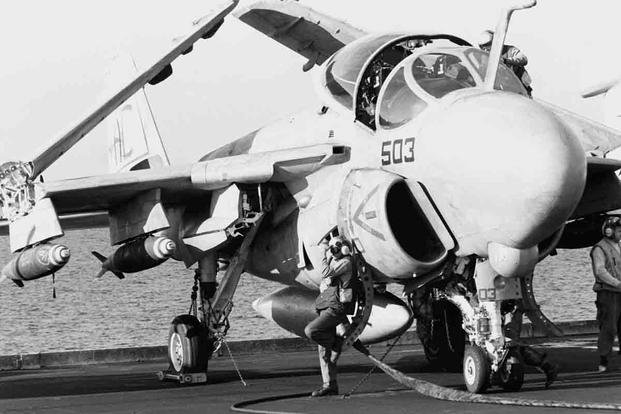It's a freak accident, but it happens more than one might think. Aircraft workers, doing their job just as they've done every day, can suddenly get swept up into a jet engine intake. In 2017, it happened to an Air India service engineer. A New Zealand aircraft engineer met the same fate in 2018.
It almost happened to a sailor during Operation Desert Storm in 1991. While preparing an A-6E Intruder for takeoff at night, 21-year-old flight deck crewman John Bridges found himself pulled into the aircraft's jet engine intake. Unlike so many others, he survived.
The USS Theodore Roosevelt was deployed to the Persian Gulf in support of Operation Desert Storm on Feb. 20, 1991. Working the flight deck in the early morning hours was Bridges and Michael McDonald. At 3:41 a.m., they were completing a pre-takeoff check of an A-6E Intruder on a precision strike mission.
Bridges' last check was making sure the aircraft was connected to the Roosevelt's catapult for takeoff. He checked out where the launching mechanism was and moved to back away from the Intruder, he began to walk forward, but didn't make it very far.
Not only was Bridges lifted off the flight deck, the intake ripped off his float coat, goggles, helmet and tools. They went into the engine first, causing a large explosion that likely saved his life.
When something other than air goes into the jet engine turbine, it would usually become a fine goo right away. Those titanium blades are spinning anywhere from 1,000 to 20,000 rotations per minute. Depending on the jet, there could be more than one set of blades, so before mixing the air with jet fuel, it's basically a giant food processor.
Unlike your Cuisinart, however, those blades aren't designed to handle the physical stress of cutting up salsa, smoothies or big chunks of meat. Since it wasn't Bridges who went in first, the tools and gear that flew in tore up the fan blades. His helmet was shredded, but it did its job and saved his life.
The pilot felt the foreign object damage immediately and cut the engines, which actually took three minutes to shut down completely. While those three minutes probably seemed like a lifetime to Bridges (and very nearly was), he had another lucky break in this freak accident: the engine size.
An intake on the A-6 Intruder isn't very big. As Bridges was sucked in, he was able to stretch out his arm and wedge himself on the bullet of the blades and the wall of the intake, holding himself just inches from certain death as the engine fully shut down.
Bridges was helped down by his fellow flight deck sailors when it was safe to help him. He walked away from the incident with a broken collarbone, a blown eardrum and some cuts and scrapes. One sailor who was aboard the USS Theodore Roosevelt at the time said Bridges did not return to the flight deck for some time.
-- Blake Stilwell can be reached at blake.stilwell@military.com. He can also be found on Twitter @blakestilwell or on Facebook.
Want to Learn More About Military Life?
Whether you're thinking of joining the military, looking for post-military careers or keeping up with military life and benefits, Military.com has you covered. Subscribe to Military.com to have military news, updates and resources delivered directly to your inbox.















